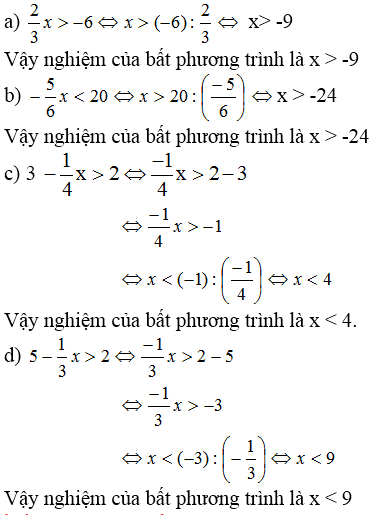
Hãy nhập câu hỏi của bạn vào đây, nếu là tài khoản VIP, bạn sẽ được ưu tiên trả lời.


a: \(x>3:\dfrac{1}{2}=6\)
b: \(x>-2:\left(-\dfrac{1}{3}\right)=6\)
c: \(x>-4:\dfrac{2}{3}=-6\)
d: \(x< -6:\dfrac{3}{5}=-10\)

a: \(x< -9:\dfrac{3}{2}=-9\cdot\dfrac{2}{3}=-6\)
b: 2/3x>-2
hay x>-2:2/3=-3
c: \(2x>\dfrac{9}{5}-\dfrac{4}{5}=1\)
hay x>1/2
d: \(\Leftrightarrow x\cdot\dfrac{3}{5}>6-4=2\)
hay x>2:3/5=2x5/3=10/3
Bài 1: Giải phương trình sau:
a)5(x-2)=3(x+1) b)\(\dfrac{2x}{x+1}\)+\(\dfrac{3}{x-2}\)=2 c)\(|2x+7|=3\)
Bài 2: Giải các bất phương trình sau:
a) (x+2)\(^2\) < (x-1)(x+1)
b) \(\dfrac{2x-1}{x+3}\) #Hỏi cộng đồng OLM #Toán lớp 8

Bài 1. Giải các phương trình sau
a) \(5\left(x-2\right)=3\left(x+1\right)\)
\(\Leftrightarrow5x-10=3x+3\)
\(\Leftrightarrow5x-3x=10+3\)
\(\Leftrightarrow2x=13\)
\(\Leftrightarrow x=\dfrac{13}{2}\)
Vậy \(S=\left\{\dfrac{13}{2}\right\}\)
b) \(\dfrac{2x}{x+1}+\dfrac{3}{x-2}=2\left(1\right)\)
Điều kiện: \(x+1\ne0\Leftrightarrow x\ne-1\) và \(x-2\ne0\Leftrightarrow x\ne2\)
\(\left(1\right)\Leftrightarrow\dfrac{2x\left(x-2\right)}{\left(x+1\right)\left(x-2\right)}+\dfrac{3\left(x+1\right)}{\left(x+1\right)\left(x-2\right)}=\dfrac{2\left(x+1\right)\left(x-2\right)}{\left(x+1\right)\left(x-2\right)}\)
\(\Rightarrow2x\left(x-2\right)+3\left(x+1\right)=2\left(x+1\right)\left(x-2\right)\)
\(\Leftrightarrow2x^2-4x+3x+3=2x^2-4x+2x-4\)
\(\Leftrightarrow2x^2-4x+3x-2x^2+4x-2x=-3-4\)
\(\Leftrightarrow x=-7\left(N\right)\)
Vậy \(S=\left\{-7\right\}\)
c) \(|2x+7|=3\)
\(\Leftrightarrow2x+7=3\) hoặc \(2x+7=-3\)
.. \(2x+7=3\Leftrightarrow2x=-4\Leftrightarrow x=-2\)
.. \(2x+7=-3\Leftrightarrow2x=-10\Leftrightarrow x=-5\)
Vậy \(S=\left\{-2;-5\right\}\)
Bài 2 bạn ghi rõ đề lại nha r mik giải lun cho
Bài 2. Giải các bất phương trình sau:
a) \(\left(x+2\right)^2< \left(x-1\right)\left(x+1\right)\)
\(\Leftrightarrow x^2+4x+4< x^2-1\)
\(\Leftrightarrow x^2+4x-x^2< -4-1\)
\(\Leftrightarrow4x< -5\)
\(\Leftrightarrow x>-\dfrac{5}{4}\)
Vậy \(S=\left\{x/x< -\dfrac{5}{4}\right\}\)
Câu b mik tính ko ra nhá sorry!!!!!!!!!!

b: |2x+3|<7
=>2x+3>-7 và 2x+3<7
=>x>-5 và x<2
c: |2x-2|>5
=>2x-2>5 hoặc 2x-2<-5
=>2x>7 hoặc 2x<-3
=>x>7/2 hoặc x<-3/2

a) \(\frac{3-2x}{5}>\frac{2-x}{3}\)
<=> \(\frac{3\left(3-2x\right)}{15}>\frac{5\left(2-x\right)}{15}\)
<=> \(9-6x>10-5x\)
<=> 9 - 10 > -5x + 6x
<=> x < -1
Vậy nghiệm của bất phương trình là x < -1
b) \(\frac{x-1}{6}-\frac{x-1}{3}\le\frac{x}{2}\)
<=> \(\frac{x-1-2\left(x-1\right)}{6}\le\frac{3x}{6}\)
<=> \(x-1-2x+2\le3x\)
<=> \(-x+1\le3x\)
<=> \(1\le2x\)
<=> x \(\ge\frac{1}{2}\)
Vậy nghiệm của bất phương trình là x > = 1/2
c) \(\frac{x+1}{3}>\frac{2x-1}{6}-2\)
<=> \(\frac{2\left(x+1\right)}{6}>\frac{2x-1-12}{6}\)
<=> 2x + 1 > 2x - 13
<=> 1 > -13 (luôn đúng)
Vậy nghiệm của bất phương trình luôn đúng với mọi x

b, \(\frac{3x-2}{5}\ge\frac{x+1,6}{2}\)
=> \(6x-4\ge5x+8\)
=> \(x-12\ge0\)
=> \(x\ge12\)
bpt 2: \(\frac{6-2x+5}{6}>\frac{3-x}{4}\)
=> \(\frac{11-2x}{6}>\frac{3-x}{4}\)
=> \(44-8x>18-6x\)
=> \(x< 13\)
Vậy để t/m cả 2 bpt thì : \(12\le x< 13\)

a, x+2/5 >=0 <=> x+2 >=0 <=> x>=-2
b. x+2/x-3 <0 <=> 1+5/x-3 <0 <=> 5/x-3 <-1 <=> x-3> -5 <=> x>-2
c. x-1/x-3 >1 <=> 1+ 2/x-3 >1 <=> 2/x-3 >0 <=> x-3 >0 <=> x>3

Chọn đáp án C